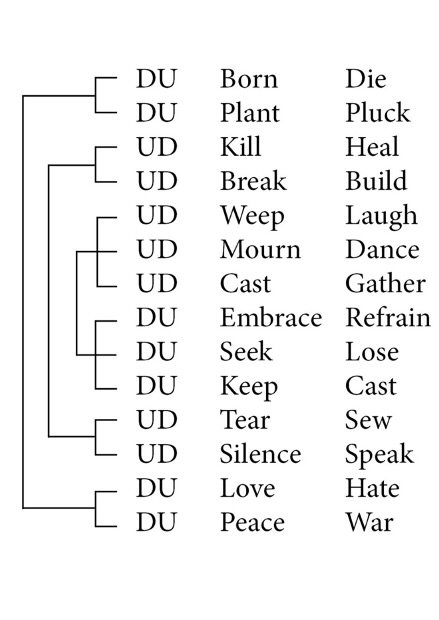Expect the Unexpected
Reflective Reading: Ecclesiastes 3:1-8
Ecclesiastes 3:1-8 reveals a beautiful form of artistry. I’m sure this poem or song is familiar to many of you, especially if you are forty or older. For every season there is a time; a time to be born, a time to die. If you are over forty, then you probably are already hearing the tune in your head. The lyrics are very catchy, and I believe they are written to be just that.
If you study the chart below, you will see a symmetrical pattern that reveals not just what the these words mean but how they mean. I realize this might be an unusual concept to grasp at first, but if you take some time to study this portion of Scripture you will begin to see the creative beauty with which God crafted His Word. Please forgive me in advance. I need to purposely make an error in one section of this chart in order to highlight an important truth (I know, that sounds weird).
Upon reading Ecclesiastes 3:1-8, it is apparent that there is some form of structure or rhythm going on. There is an obvious theme of “comparison and contrast.” Today, we’re going to build on this idea of comparison and contrast to highlight an important truth.
Next to each set of words, we are going to write a “D” for DESIRABLE and/or a “U” for UNDESIRABLE experiences. For example, in the first set of words, Born and Die, to be born is Desirable; to die is Undesirable.
The chart looks something like this:
Beautiful, right? It is at first glance. Upon concluding this poem/song however, Solomon writes,
“What profit then has the laborer in all his toil?” (3:9)
Seems like an odd question to ask after this beautiful symmetrical poem, right? However, it’s really a perfect question. You see, because of my purposeful error (sorry, it was necessary), this poem does not really give us that perfect symmetry. The last line does not read PEACE and WAR as written above, but WAR and PEACE. And this disrupts the whole frame! The beauty doesn’t really exist! Rather, this unexpected discordant ending creates an abrupt tension. The enjoyment of this gracefully flowing poem, has been replaced with an unexpected cacophony.
It’s like Bach writing a beautiful symphony only to end it with a discordant clanging of cymbals. Why did Solomon implement this unsettling device?
Let’s return to the text:
“What profit then has the laborer in all his toil?”
A Hebrew reader or listener to this poem or song would have expected it to end with a delightful symmetrical tone. Instead they are left with dissonance, disruption, and discontinuity. Why? Solomon is making an unforgettable statement to his readers: Don’t get blindsided when life throws you a curveball. Expect the unexpected—it’s going to happen!
When Solomon writes, “What profit then…” it is akin to him saying, “Why bother! Why bother if I can’t expect life to have a certain amount of certainty?!” If I am living a godly life and have three beautiful children and a husband who loves me, then why did I get cancer?! If am living a life of integrity and working diligently, then why did I just get fired?! If I have been a godly husband, then why did my wife file for divorce?! If I raise my children…fill in the blank. The question is why? Why bother working so hard, and why bother trusting God, if all of life is going to dish out these unexpected, undesirable events?
God will explain why in the next verse:
“I have seen the task, which God hath given to the sons of men to be exercised in it” (Ecclesiastes 3:10).
The word task, also translated as business, carries the idea of our occupation or the work that keeps us busy trying to put bread on the table. The word exercised carries the idea of being browbeaten, depressed, afflicted, or humbled. Though a godly life will give you a good return and good rewards, there are times when God gives us something unexpected and undesirable. These undesirable events keep us off-balance in order to humble us so that we will turn to God and trust him.
The next verse reinforces this interpretation:
“He has made everything beautiful in its/his time” (Ecclesiastes 3:10-11).
What a beautiful, albeit unexpected, conclusion!
Friends, there will be times when we will face unexpected, undesirable events. Sometimes these events come at a time when everything seems to be going wonderfully; we don’t have a care in the world. Then, just like the beautiful symmetrical poem with the dramatic and unexpected ending, God is working out a plan that we cannot anticipate. Yet, we can be comforted in the fact that God is in control. He is writing a story more beautiful and intricate than anything we could have imagined, and we must trust him to write our story.
The take away is this, “Humble yourselves therefore under the mighty hand of God, that he may exalt you in due time” (I Peter 5:6). And do not lose heart, God is making something beautiful out of you, in His time.
Sincerely,
Mark Hamby
M.S., M. Div., Th. M., D. Min.
Recommended Reading:
Hungering and Thirsting book or audio drama (Ages 6+)
From Press to Pulpit (Ages 9+)
Come What May (Ages 12+)
Idols of the Heart (Ages 12+)
